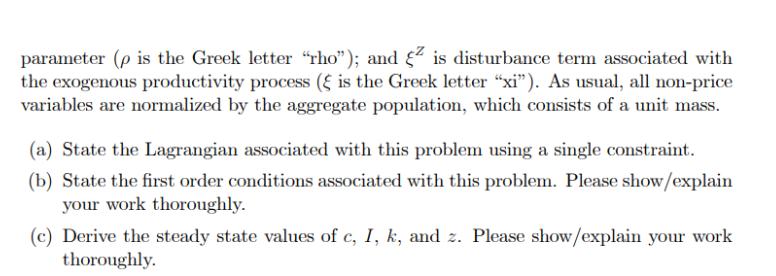Answered step by step
Verified Expert Solution
Question
1 Approved Answer
Consider the following planning economy problem: such that and In addition, max Et Ct,kt+1 t=0 Bt 1-o q+It=yti Yt = 2+k; 2 kt+1= It+


Consider the following planning economy problem: such that and In addition, max Et Ct,kt+1 t=0 Bt 1-o q+It=yti Yt = 2+k; 2 kt+1= It+ (18) kt. In z = pln z-1 + 7. Above: c is aggregate consumption; k is the aggregate capital stock; E, is the ex- pectation operator conditional on the information available up and through period t inclusive; 3 (0, 1) is the subjective parametric discount factor (3 is the Greek letter "beta"); y is aggregate output; I is aggregate investment; d > 0 is the depreciation rate of capital (8 is the Greek letter "delta"); z is productivity; a (0, 1) is a parame- ter (a is the Greek letter "alpha"); p (0,1) is the productivity process persistence parameter (p is the Greek letter "rho"); and 2 is disturbance term associated with the exogenous productivity process ( is the Greek letter "xi"). As usual, all non-price variables are normalized by the aggregate population, which consists of a unit mass. (a) State the Lagrangian associated with this problem using a single constraint. (b) State the first order conditions associated with this problem. Please show/explain your work thoroughly. (c) Derive the steady state values of c, I, k, and z. Please show/explain your work thoroughly.
Step by Step Solution
★★★★★
3.41 Rating (148 Votes )
There are 3 Steps involved in it
Step: 1
a The Lagrangian associated with this problem is Lc k z t0infty t ct1sigma kt t0infty ct1sigma kt wh...
Get Instant Access to Expert-Tailored Solutions
See step-by-step solutions with expert insights and AI powered tools for academic success
Step: 2

Step: 3

Ace Your Homework with AI
Get the answers you need in no time with our AI-driven, step-by-step assistance
Get Started


